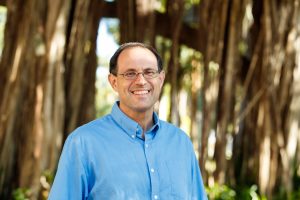
Ask Uzi Baram, Ph.D. about the in-depth history of archaeological Southwest Florida and prepare to be wowed.
Few scholars know more about the region than the New College professor of anthropology and heritage studies. And now his expertise (and that of his colleagues) is all available in one place—the first-ever virtual tour of Sarasota-Manatee’s past, which was designed to inform the public about historical sites and raise awareness about preservation.
It is called “Archaeology SRQ: A Story of Sarasota-Manatee (Florida’s Archaeological Past, Present and Future),”—funded by a $5,000 grant from the Florida Humanities and hosted by the Time Sifters Archaeology Society.
“I have been doing an accelerated number of public presentations on Florida archaeology, all about climate change and the rising sea levels on the coast, since 2018,” said Baram, who is the director of the New College Public Archaeology Lab. “One of the things we’re seeing is that archaeological sites on the coast (which have been stable for 6,000 years) are getting inundated. The number of people who have never heard about these places nearby is shocking, and nobody is going to work to save something they don’t know is there.”
So Baram (with his more than two decades worth of scholarship) is letting people know what is here—including land where indigenous people built shell mounds and cemetery sites.
The collaborative online project took about a year to produce, and Baram even assigned a virtual guide for the personalized tour: circus magnate and influential figure Charles Ringling (1864-1926), who takes viewers back in time to what Sarasota was like a century ago.
“I thought a booklet by itself was not going to be enough to get people’s attention, so we went online with this whole project. I had explored the idea with my ‘Archaeology of Florida’ class, and my students were intrigued,” Baram said. “We have to honor the heritage and land we’re living on. I also have tremendous concern about what we’re going to lose as the sea levels rise. What’s on the webpage are the struggles of thousands of people, and this creates a better context to talk about our local challenges.”
For the project, Baram picked his students’ brains about interesting topics that could be included on the website. Apart from its statewide historical significance, the website now serves as an excellent resource for Baram’s archeology courses at New College, including “The Archaeology of Florida,” “Method and Theory in Archaeology,” “Heritage: History and the Past Today” and “Race and Ethnicity in Global Perspective.”
“This site fills an important niche for the Florida southwest coast and will be offered as a model for other Florida regions,” Baram said. “While archaeology and its findings continue to be of intense public interest (as seen in media coverage, public attendance at archaeology presentations, visitations to museums and virtual exhibits, and attention given to current projects at local archaeological and historical sites), there is no readily accessible information for the region between Tampa Bay and Charlotte Harbor.”
Even for the state, the most recent single-authored scholarly work on Florida’s archaeology is Jerald Milanich’s The Archaeology of PreColumbian Florida from 1994—and, for historic preservation, it is Heart and Soul of Florida: Sacred Sites and Historic Architecture by Elsbeth Gordon from 2013, Baram said.
“While specific sites have scholarly publications—for general interest in the sweep of history (from the earliest evidence at Little Salt Spring at 14,000 years old to the present), there was nothing available,” Baram said.
There wasn’t. But there is now.
To access the virtual tour, visit timesifters.org/archaeology-srq.
Yasi Bahmanabadi is an intern in the Office of Communications & Marketing.